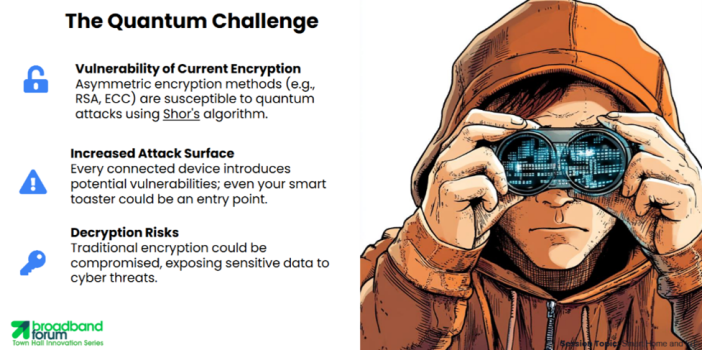 Marco van den Akker, CEO at eighttoseven (its name owing to the 8-to-7-bit encoding method) delivered an engaging presentation on how transitioning to quantum-resistant encryption solutions can help IoT systems withstand future quantum threats.
Marco van den Akker, CEO at eighttoseven (its name owing to the 8-to-7-bit encoding method) delivered an engaging presentation on how transitioning to quantum-resistant encryption solutions can help IoT systems withstand future quantum threats.
Sensitive data has become a prime target for cyberattacks. Robust security is paramount, stressed van den Akker, particularly when there are more than 75 billion connected devices expected by 2025 and quantum computing continues to advance. As each new IoT device joins our networks, it increases the potential attack surface and consequently makes it easier for cybercriminals to exploit weaknesses.
With the advent of 6G and Wi-Fi 7 also bringing significant security vulnerabilities, more must be done to protect data integrity, van den Akker advised. Quantum computers can efficiently break traditional encryption algorithms like RSA and ECC, rendering them susceptible to attacks. They possess exponential computing power which means that they can potentially compromise these encryption methods in broadband networks within seconds. To navigate these threats, quantum-resistant encryption solutions can provide resilient data protection that prevents any unauthorized access to sensitive information and ensure data remains secure.

Van den Akker highlighted that efficiency, scalability, and interoperability in modern quantum-resistant encryption solutions are paving the way for a more secure and robust IoT ecosystem. They are compatible with existing network infrastructure to shorten implementation times and promote widespread adoption. They also overcome resource constraints, such as limited processing power, inherent in many IoT devices.
It was highlighted that the continued standardization efforts in post-quantum cryptography is being led by the National Institute of Standards and Technology (NIST) in the quest for universal protocols for quantum-resistant security across various sectors and critical infrastructure. During the presentation, van den Akker pointed out that a number of organizations have already started to implement quantum-resistant encryption algorithms, highlighting the rising industry awareness and commitment to safeguard against future quantum threats.
Advanced encryption algorithms are also minimizing computational overhead, which is critical for real-time data protection. For example, the likes of PQCS solutions use only 4-7% of CPU capacity, translating to 53% faster encryption and decryption processes.
However, it is vital that these modern solutions are able to adapt to the growing IoT landscape. Not only do they need to function on high-powered systems and low-processing devices, but they must be able to seamlessly integrate in both simple smart home set ups and complex Industrial IoT (IIoT) environments.
While there remains work to be done, van den Akker advised that the development of comprehensive guides and training sessions on quantum-resistant encryption can help promote user understanding and compliance on the importance of security in the smart home.
When it comes to device management, updating the Broadband Forum’s TR-069 and USP standards to incorporate quantum-resistant encryption, including the eighttoseven algorithms, was proposed to define secure methods for firmware updates and configuration changes. These guidelines for secure remote management of IoT devices will further help maintain the integrity of broadband networks.
To combat current and future threats, new working texts within the Broadband Forum that outline quantum-safe home network architectures can provide the framework that is scalable for the growing number of IoT devices. Through collaboration, the industry can create an open-source library for quantum-resistant encryption for IoT developers and manufacturers to integrate into existing and future products, van den Akker proposed.
